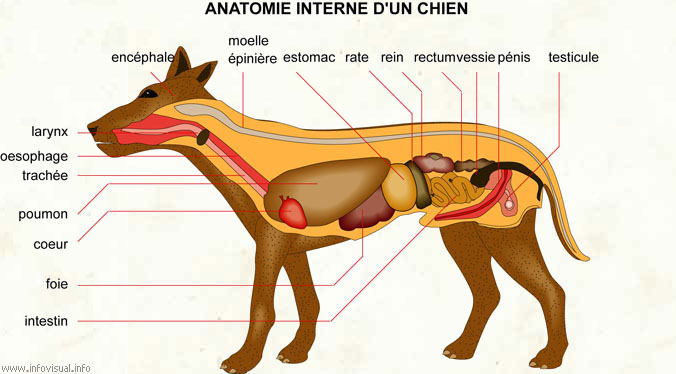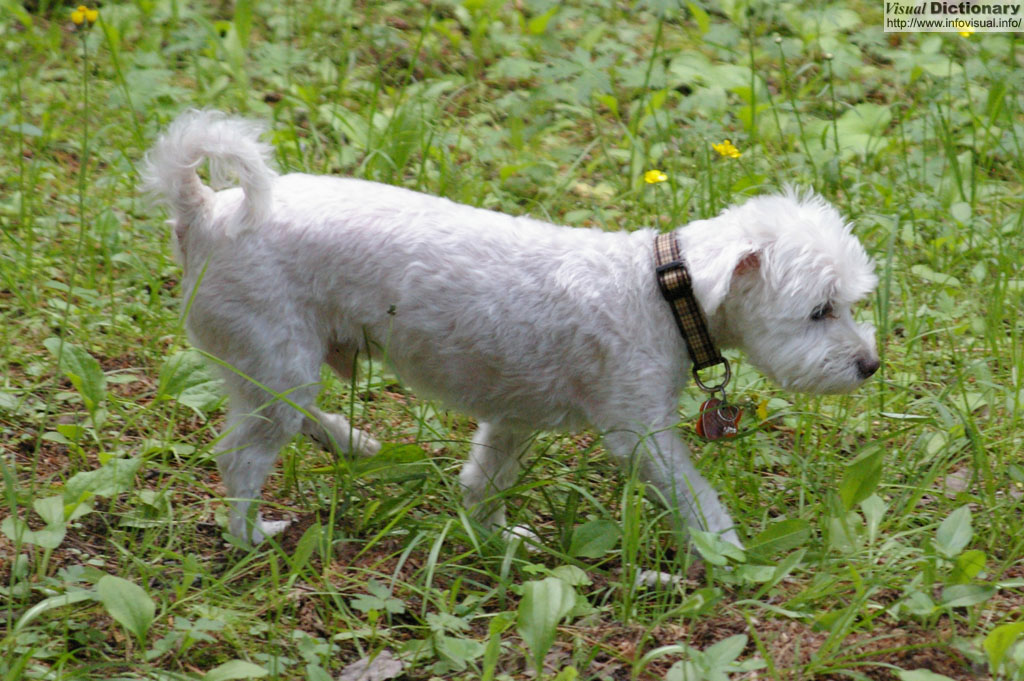Anatomie interne d'un chien

Encéphale: siège des capacités intellectuelles du chien.
Moelle épinière: partie importante du système nerveux.
Estomac: partie du tube digestif située entre l'oesophage et l'intestin.
Rate: organe hématopoïétique fabriquant des lymphocytes.
Rein: organe de purification sanguine.
Rectum: dernière partie de l'intestin.
Vessie: poche dans laquelle s'accumule l'urine avant d'être éliminée.
Pénis: organe sexuel mâle servant à la copulation.
Testicule: organe sexuel mâle fabriquant les spermatozoïdes.
Intestin: dernière partie du tube digestif.
Foie: glande digestive fabriquant la bile.
Coeur: organe de pompage sanguin.
Poumon: organe respiratoire.
Trachée: tube transportant l'air aux poumons.
Oesophage: première partie du tube digestif.
Larynx: partie de la gorge du chien où sont situées les cordes vocales.
Photo :

Maltese can be very energetic, despite this they still do well for apartment dwellers. They are relatively easy to train and enjoy a playful game of fetch. These intelligent dogs learn quickly, and pick up new tricks and behaviors easily. Characteristics include slightly rounded skulls, with a one-finger-wide dome and a black nose that is two finger widths long. The body is compact with the length equaling the height. The drop ears with long hair and very dark eyes, surrounded by darker skin pigmentation that is called a "halo", gives Maltese their expressive look. Their noses can fade and become pink or light brown in color. This is often referred to as a "winter nose" and many times will become black again with increased exposure to the sun.
The coat is long and silky and lacks an undercoat. The color is pure white and although cream or light lemon ears are permissible, they are not desirable. Some individuals may have curly or woolly hair, but this is outside the standard. The Maltese while growing may get curly fur. They are very cute. Adult Maltese range from roughly(1.4 to 3.0 kg, though breed standards, as a whole, call for weights between 1.8 to 3. kg. There are variations depending on which standard is being used; many, like the American Kennel Club, call for a weight that is ideally less than 7 lb with between 4 and 6 lb preferred.
For all their diminutive size, Maltese seem to be without fear. In fact, many Maltese seem relatively indifferent to creatures/objects larger than themselves, which makes them very easy to socialize with other dogs, and even cats. They are always happy, cheerful, smart and do not like to get into trouble. They tend to get very lonely if the master is not with them and taken care of and it doesn't like being left out. This is because they were bred to be companion dogs and thrive on love and attention. They are extremely lively and playful, and even as a Maltese ages, his/her energy level and playful demeanor remain fairly constant and does not diminish much.
Maltese are very good with children and infants. Maltese can sometimes be snappy and mean. Maltese do not require much physical exercise, although they should be walked daily to reduce problem behavior. They enjoy running and are more inclined to play games of chase, rather than play with toys. Maltese can be snappy with littler children and should always be supervised when playing. Socializing at a young age will reduce this habit. They can be very demanding and, true to their nature as "lap dogs", love to cuddle and often seek this sort of attention. The Maltese is very active in the house, and, preferring enclosed spaces, does very well with small yards. For this reason the breed also does well with apartments and townhouses, and is a prized pet of urban dwellers. They are incredibly friendly dogs to people they know. With strangers they will make a high pitched bark but will quiet down if the person means no harm.
Animation : Les chiens: les connaître, les comprendre.
Merci à YouTube de nous permettre d'observer ce vidéo.
Objet virtuel : Les chiens: les connaître, les comprendre.
Merci à YouTube de nous permettre d'observer ce vidéo.